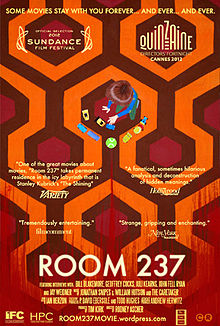Movie Review: Room 237 (2013)

Let me make this clear: I love The Shining. It is an amazing film and I have watched it probably somewhere in the range of ten plus times. That being said, the subjects being interviewed in Room 237 are well and truly infatuated with this film beyond the realms of anything that would be considered normal, average or even healthy.
Director Rodney Ascher has assembled a range of people who draw the most tenuous links to their own theories, between the innocuous placement of cans signifying Indian genocide or indeed how The Shining is related to Kubrick’s own telling of the Holocaust. Now, this is not to say that some of the theories in Room 237 don’t have merit, because some do, nor is it to say that some of the theories are outright ridiculous as there is no definitive proof one way or the other and this is what I really think Room 237 is all about. That a film can mean that much to these people, that they will obsess over it and watch it so many times that patterns have appeared to them or they have noticed some slight differences in scenes and that inside their mind that they will (and have) pieced together their own theories. The five theorists interviewed (Bill Blakemore, Geoffrey Cocks, Juli Kearns, John Fell Ryan, Jay Weidner) all have differing opinions on what The Shining is really about, whether that be how Kubrick was involved in faking the moon landing footage or (as with most analyzed subjects) sex. However, it’s not about the theories (as entertaining or crackpot as they maybe). What this is about is how the film has survived the test of time. 
Ascher never once lets you see those you hear talking, instead using footage from all of Kubrick’s films (and splicing a few random others to emphasize points being made), Ascher tries to create his own maze with this film. Some of the frame by frame analysis hammers home the point that these enthusiastic, Kubrick lovers really do know the film back to front (which happens – a super imposed The Shining playing from the start over a super imposed The Shining playing from the end backwards at the same time). They point out many either deliberate ploys or many pieces of poor continuity, but the interviewees all standby their convictions, that nothing in The Shining is by accident.
Broken down in nine segments the film tackles one point after another which each part being commented on by all the interviewees each with their own story to tell on a particular point or moment in the film. Unfortunately, this is where Room 237 comes unstuck with the repeated footage now starting to grind on you, so by about midway through the film, you aren’t seeing anything new.
Room 237 is best imagined if you were stuck in an art gallery looking at the one painting. Every nuance, every crack, every alley and avenue is explored and it gets to a point where it is almost exhausting. This is art and art as it is should be analyzed to the tiniest degree and film should be no different. Kubrick was a renowned perfectionist, so it seems quite fitting that this film is being analyzed on a scale that would probably match Kubrick’s obsessive directorial style.
Are the theories in Room 237 correct? It is unlikely, but it doesn’t matter. The real story is the power of The Shining and its ability to enthrall, even today.

April 23, 2013
These sort of theories are fun to contemplate but probably are far from the actual truth – kind of like playing Wizard of Oz to Pink Floyd’s Dark Side of the Moon. Eerie, but again, probably simply coincidental.
April 25, 2013
Yes very true. Pure coincidence but it just goes to show how much some films are a part of peoples lives…even if it is to the degree shown here!!